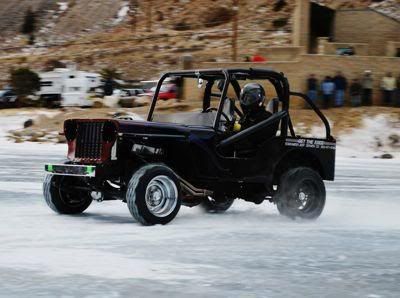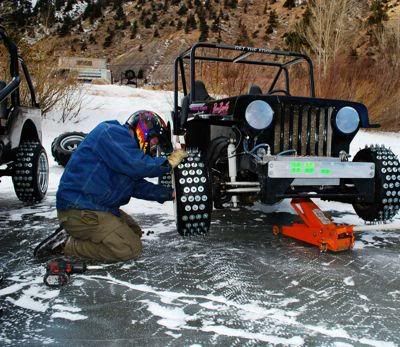Tire Pressure in Ice?
#11
JK Freak
When discussing a tire's ability to gain traction on ice, one must understand the physics involved. Is it wet ice or dry? Static or dynamic friction?
Let's just make it simple. Friction is not dependent upon area. Friction is dependent upon load and whether or not there is mechanical interference between the two surfaces. If you double the area, you halve the load, thus no increase in friction. A good example of mechanical interference are studded tires.
Ice is hard. Ice cold tires are relatively hard as well. There is not any significant mechanical interference between the surfaces. Wet ice is worse as it results in a lubricated surface. Winter tires have gozillions of sipes to squeegee out much of the water, reducing the lubricating effect of the water. But, winter tires offer little to no improvement over normal tires on dry ice.
High performance summer tires get grip by using a very soft compound that generates a lot of mechanical interference (at the molecular level). In short, they are termed as being "sticky" for a reason. When at optimum operating temperature, they are sticky. However, these compounds dramatically harden when cold and lose their ability to adhere at the molecular level.
In short, it does not matter what your tire pressures are when on ice. The coefficient of friction doesn't change with increased or decreased area.
My regards,
Widewing
Let's just make it simple. Friction is not dependent upon area. Friction is dependent upon load and whether or not there is mechanical interference between the two surfaces. If you double the area, you halve the load, thus no increase in friction. A good example of mechanical interference are studded tires.
Ice is hard. Ice cold tires are relatively hard as well. There is not any significant mechanical interference between the surfaces. Wet ice is worse as it results in a lubricated surface. Winter tires have gozillions of sipes to squeegee out much of the water, reducing the lubricating effect of the water. But, winter tires offer little to no improvement over normal tires on dry ice.
High performance summer tires get grip by using a very soft compound that generates a lot of mechanical interference (at the molecular level). In short, they are termed as being "sticky" for a reason. When at optimum operating temperature, they are sticky. However, these compounds dramatically harden when cold and lose their ability to adhere at the molecular level.
In short, it does not matter what your tire pressures are when on ice. The coefficient of friction doesn't change with increased or decreased area.
My regards,
Widewing
#13
JK Super Freak
Join Date: Dec 2008
Location: Crawlorado
Posts: 1,028
Likes: 0
Received 0 Likes
on
0 Posts
here in colorado they race jeeps on lake dillon i will try to find more info on what tires they use and tire pressure. i would think they have spikes in their tires
#15
JK Enthusiast
I've been here 11 years, the 40 before that were in Michigan. Six of those, including the years I learned to drive, got my first drivers license and got my first car were all in the Garden peninsula of the upper peninsula of Michigan. Where most of the winter it is so cold salt will not melt ice, so you just drive on it. Generally with studded tires, if you actually wanted to go anywhere.
Last edited by hig4s; 01-24-2009 at 02:18 PM.
#16
JK Super Freak
I've been here 11 years, the 40 before that were in Michigan. Six of those, including the years I learned to drive, got my first drivers license and got my first car were all in the Garden peninsula of the upper peninsula of Michigan. Where most of the winter it is so cold salt will not melt ice, so you just drive on it. Generally with studded tires, if you actually wanted to go anywhere.
#17
There's a thread about tire pressure in deep snow, but what about ice? The dynamic is a bit different, I would assume.
In deep snow the snow will conform to the tire so you do not want to air down, but what about on ice?
Especially if you have mud tires, do you want to air down to get more surface area?
I have siped mud tires, but this season while going up to the mountains I did notice that these tires struggled a lot more than my stock all terrains to hold traction in icy road conditions.
In deep snow the snow will conform to the tire so you do not want to air down, but what about on ice?
Especially if you have mud tires, do you want to air down to get more surface area?
I have siped mud tires, but this season while going up to the mountains I did notice that these tires struggled a lot more than my stock all terrains to hold traction in icy road conditions.
#18
JK Freak
Don't assume anything about ice. As I stated earlier, friction is independent of area. Load, not area determines friction. It doesn't matter if you air down or up, the load factor remains unchanged. Friction is limited, as it cannot increase above the coefficient of friction between the two surfaces without a modifying factor (sand, studs, or water, which lubricates the ice), regardless of load.
To gain traction, one must introduce a mechanical interaction. In other words, the vehicle must penetrate the surface of the ice to get a mechanical bite. Tires alone cannot do that because ice is the harder surface. Studded tires, or cable chains (not as good as studs) will do that. Rough ice can offer some traction as the tire tread can get some minuscule bite. Sand is a great help because it interacts both with the ice and the tires.
My regards,
Widewing
#20
JK Super Freak
widewing has got it right, i use a double row studded winter tire as we get a lot of ice on the back roads. over the years i have tried a number of combinations airing down, up wide and narrow tires and nothing comes close to a good studded winter tire.







